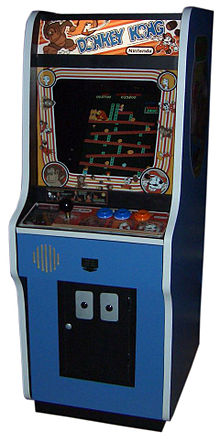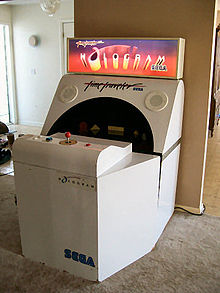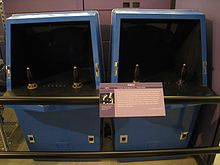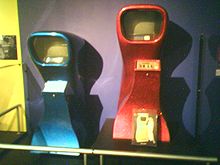Arcade game
![]()
This article describes paid video games. For the game mode, see Game mode (computer game)#Arcade mode.
![]()
This article or subsequent section is not sufficiently supported by evidence (e.g., anecdotal evidence). Information without sufficient evidence may be removed in the near future. Please help Wikipedia by researching the information and adding good supporting evidence.
Arcade game is a term for video games that have been offered for a fee since the 1970s in public gaming houses in the USA, so-called penny arcades, or in Europe in amusement arcades. In the early 1980s, arcade machines were installed in Germany not only in arcades but also in many snack bars, kiosks and supermarket vestibules until this was prohibited by law. Arcade machines allow the user to play against money. The game price in Germany was usually one D-Mark, while abroad it was usually lower. Successful games were later often converted for the PC as well as for various video game consoles.
The first commercial arcade game was Computer Space (1971) by Nutting Associates. The inventor was Nolan Bushnell, who later also founded Atari. In the late 1970s as well as in the early 1980s, arcade classics such as Space Invaders, Pac-Man, Donkey Kong and many more, which are still well-known and popular through re-releases, appeared during the heyday of arcade machines. At the end of the 1980s, the arcade boom slowly ebbed due to the ever more widespread home computers and video game consoles. Today, only a few arcade machines can still be found in Germany.
Arcade games were the basis for the success of the computer game industry in the early years. The first big success was the game Pong. Most of the older games can also be emulated today with M.A.M.E. As part of artistic projects (arcade art), such as Blinkenlights, Pong was displayed on a house wall.

The arcade game Donkey Kong
Typical features of arcade games
The point of arcade games is to bring in money. The average playing time is therefore often relatively short. The game principle is easy and quickly transparent, a possible tutorial is kept very short. The difficulty of the game is also adapted to the intention of the machine:
- The first rounds or levels are often still relatively easy to complete successfully. This should give the player the impression that he has mastered the game.
- In the following rounds, the difficulty level increases noticeably, beginners already have to accept setbacks and quickly receive a "Game over". However, in most arcade games you can buy another try by throwing money in again (Continue).
- The renewed insertion of money is "rewarded" by some arcade games (invisible) with a short-term lowered difficulty level again. This is to give the player the impression that he has become better or simply had bad luck on the first try.
In addition, the machine manufacturer can usually adjust the difficulty level by means of one or more DIP switches, so that the games are not equally difficult everywhere.
Chronicle
Before arcade "video" games, mechanical and electro-mechanical arcade games, one-armed bandits and pinball machines were particularly common in amusement arcades, as were games of skill and sports games.
Early chronicle
(selection)
- 1971: First commercial arcade game Computer Space by Nolan Bushnell (Nutting Associates)
- 1972: Pong (Atari) first successful game
- 1974: Quadra Pong (for 4 players)
- 1974: Gran Trak 10 (Atari) first racing simulation, already with steering wheel, first with ROMs
- 1974: Tank (Kee Games/Atari) first game with ROM memory for graphics
- 1974: Touch-Me (Atari) predecessor of Senso
- 1975: Gun Fight (Bally Midway) first game with microprocessor
- 1976: Breakout
- 1976: Heavyweight Champ (Sega) Japan's first commercial video game
- 1976: Night Driver (Atari) first 3D racing simulation
- 1977: Circus
- 1977: Space Wars (Cinematronics) first vector arcade game
Starting around 1978, the golden era of arcade games begins.
Chronicle 1978-1984
- 1978: Space Invaders (ushered in the era)
- 1978: Football (Atari, first game with trackball)
- 1979: Asteroids
- 1979: Galaxian (first game with real color graphics)
- 1979: Lunar Lander
- 1979: Subs (Atari, first game with 2 monitors)
- 1980: Battlezone (3D tank simulation)
- 1980: Berzerk
- 1980: Centipede
- 1980: Defender (first with scrolling)
- 1980: Pac-Man (first game with commercial character)
- 1980: Phoenix
- 1980: King and Balloon (Namco, first with voice-over)
- 1980: Missile Command
- 1980: DECO Cassette System (Data East) first standard platform
- 1980: Space Panic (first platform game)
- 1980: Star Castle
- 1980: Tempest
- 1980: Warlords
- 1980: Wizard of Wor
- 1981: Donkey Kong (first Jump `n` Run)
- 1981: Frogger
- 1981: Lady Bug
- 1981: Galaga
- 1981: Peat
- 1981: Ms. Pac-Man
- 1981: Qix
- 1981: Scramble
- 1981: Vanguard
- 1982: Burger Time
- 1982: Dig Dug
- 1982: Donkey Kong Jr.
- 1982: Joust
- 1982: Jungle Hunt
- 1982: Kangaroo
- 1982: Moon Patrol
- 1982: Pengo
- 1982: Pole Position (one of the most popular racing games of all time)
- 1982: Popeye
- 1982: Q*Bert
- 1982: Robotron: 2084
- 1982: Time Pilot
- 1982: Tron
- 1982: Xevious
- 1982: Zaxxon (the first game with isometric display)
- 1983: Crystal Castles
- 1983: Dragon's Lair (first with laserdisc)
- 1983: Gyruss
- 1983: Mappy
- 1983: Mario Bros.
- 1983: Elevator Action
- 1983: Nibbler
- 1983: I, Robot (first commercial game with 3-D polygons)
- 1983: Spy Hunter
- 1983: Star Wars
- 1983: Tapper
- 1984: TX-1 (first game with 3 monitors for 1 person, see Buggy Boy)
- 1984: Bomb Jack
- 1984: Paperboy
Milestones after the 1984 crash
- 1985: Marble Madness
- 1985: Commando
- 1985: 1942
- 1985: Ghosts 'n Goblins
- 1985: Choplifter
- 1985: Gauntlet (Atari, 4-player adventure game)
- 1986: Arkanoid
- 1986: Bubble Bobble
- 1986: Rolling Thunder
- 1986: Out Run (Sega, first force feedback car race)
- 1987: Rainbow Islands
- 1987: Yōkai Dōchūki (Namco, first game with 16-bit graphics)
- 1988: Tetris
- 1989: Exterminator (first with fully digitized graphics)
- 1991: Street Fighter II
- 1991: Terminator II
- 1991: Time Traveler (Sega, first hologram game)
- 1992: Mortal Kombat (Part 1)
- 1992: Virtua Racing (Sega, multi-player racing with polygons)
- 1992: Virtua Fighter (Sega, first polygon beat-'em-up)
- 1993: Mortal Kombat II (best sound system, with MP3 compression)
- 1993: Daytona USA (Sega, first polygon based racing game with texture mapping and bilinear texture filtering/perspective correction)
- 1994: Virtua Fighter 2
- 1995: Sega Rally
- 1997: Super GT (Sega, 64-bit)
- 1998: Dance Dance Revolution (with dance mat)
- 1999: Crazy Taxi

Sega's Time Traveller

Galaxy Game, 1971, First ever arcade game in the world

First commercial arcade game: Computer Space, 1971
Search within the encyclopedia